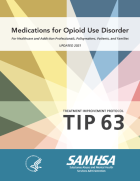This document accompanies the Clinical Guidance for Treating Pregnant and Parenting Women with Opioid Use Disorder and Their Infants publication. It offers information about child welfare systems and what the health care provider's role is in developing a Plan of Safe Care.
Dashboard: Filter Bricks
Main page content


The fourth supplemental resource to SAMHSA’s Clinical Guidance for Treating Pregnant and Parenting Women with Opioid Use Disorder and Their Infants publication. This document contains information for pregnant people with a substance use disorder and preparing to deliver.

The National Guidelines for Child and Youth Behavioral Health Crisis Care offers best practices, implementation strategies, and practical guidance for the design and development of services that meet the needs of children, youth, and their families experiencing a behavioral health crisis. Additional technical guidance is provided in a companion report produced by SAMHSA in conjunction with the National Association of State Mental Health Program Directors, A Safe Place to Be: Crisis Stabilization Services and Other Supports for Children and Youth.

There are protections in federal law, collectively known as “parity,” which are designed to ensure that certain types of health plans cover mental and substance use disorders no less generously than they cover other health issues. This resource can guide you to helpful materials and places.

This Advisory reviews the evidence on prescription stimulant misuse among youth and young adults. It establishes prescription stimulant misuse as a public health problem, identifies associated risk and protective factors, and provides programs and action steps for stakeholders to prevent misuse.

This Treatment Improvement Protocol (TIP) reviews the use of the three Food and Drug Administration (FDA)-approved medications used to treat OUD—methadone, naltrexone, and buprenorphine—and the other strategies and services needed to support recovery for people with OUD. This is a revision.

Alcohol remains the number one substance used by young people. These 24 legal policy summaries allow you to track how your state regulates underage drinking as compared to other states in order to help inform your prevention work.

This chartbook uses combined 2015 to 2019 data from the National Survey on Drug Use and Health (NSDUH) to present nationally representative estimates of mental health service utilization among adults aged 18 or older and adolescents aged 12 to 17 within different racial/ethnic groups in the United States. The percentages are annual averages.

This report provides an update on a series of topics focusing on substance use and mental health (collectively referred to as behavioral health) in the United States. SAMHSA selected specific topics and indicators in this report to represent a cross-section of the key behavioral health indicators that are assessed in SAMHSA data collections, including NSDUH. This report is intended to provide a concise, reader-friendly summary of key behavioral health measures for lay and professional audiences.

Esta hoja informativa se puede usar como una guía para las personas que buscan tratamiento de salud mental. Ofrece tres pasos necesarios para llevar a cabo antes de utilizar un centro de tratamiento, así como las cinco señales de un centro de tratamiento de calidad, que incluye revisar la acreditación, la medicación, las prácticas basadas en la evidencia, el papel de las familias y las redes de apoyo.
Displaying 1 - 10 out of 11

